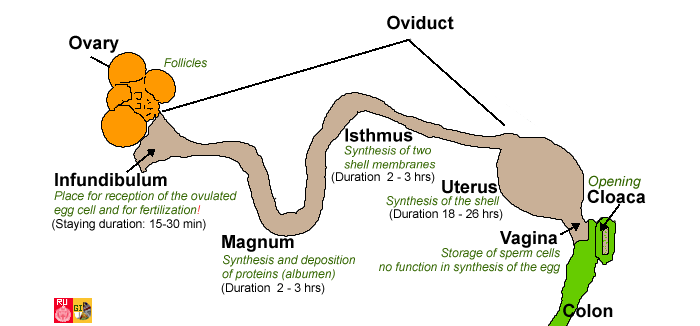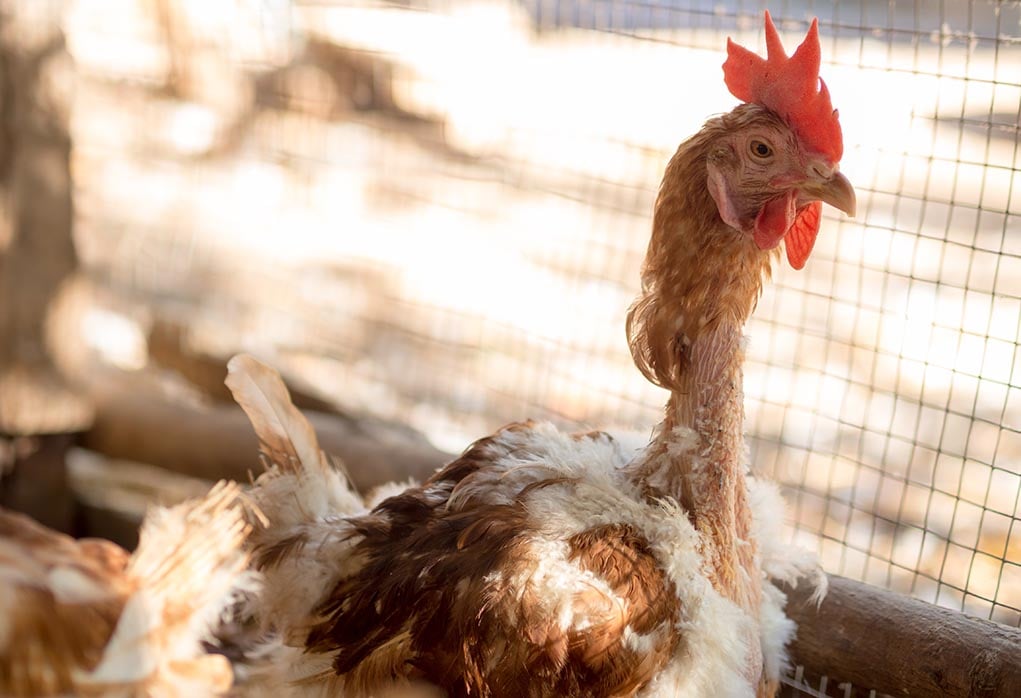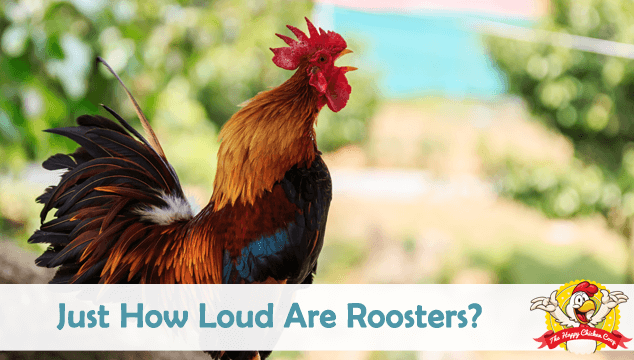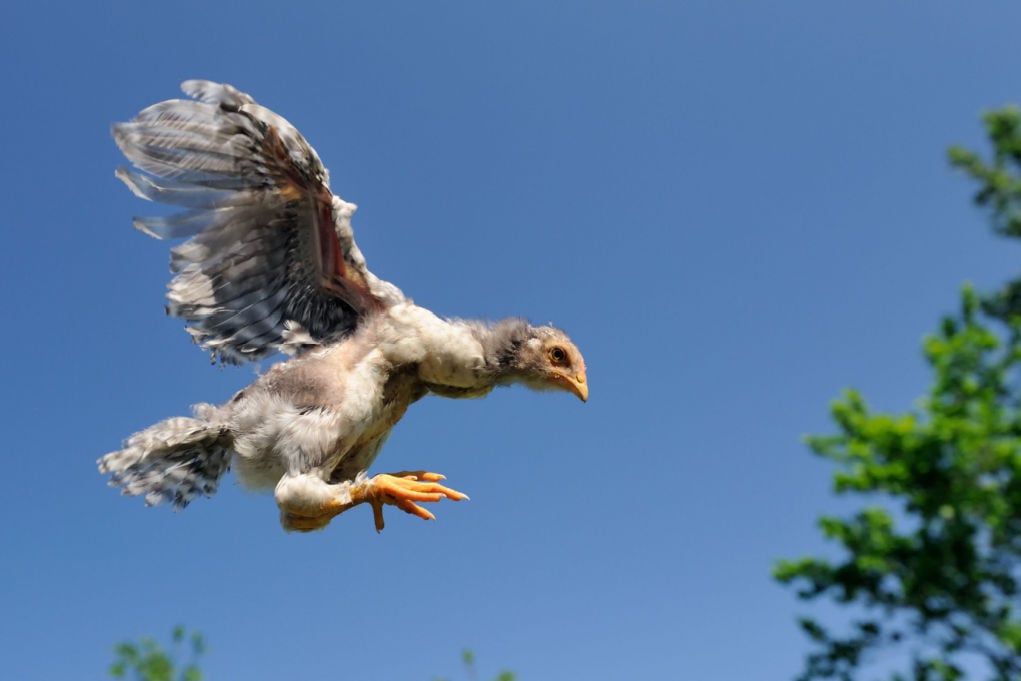Our ‘topic of today’ is all about how chickens make and lay those delicious ‘cackleberries’ that we all love!
We usually don’t think too much about the ‘how’ of egg laying – I think it is fascinating – I hope you will agree. It is a long and fairly complex process which can occasionally be fraught with problems, some of which we will discuss here today.

Time & Hormones – The Internal Clock
Nearly all birds and mammals have a ‘hormonal clock’. When it activates is variable by species, but when that point is reached hormones start to flow through the body causing several changes to occur.
In the pullet you will see her comb start to redden, her body will fill out a little bit and her behavior may be erratic for a while. This is all triggered by the release of hormones – predominantly estrogen in pullets.
She may start to cluck and cackle while going from nest to nest looking for a good spot. She is probably a bit confused since she doesn’t know what’s going on, but once she lays that egg she will soon get the hang of it and it will become her daily routine for the next year or so until the molt.
Once she has laid that all important first egg, she gets accepted by the older hens into the ‘Layers Club’. Think I’m crazy? Watch how the older hens behave to a pullet once she starts to lay.
Some breeds take longer than others to reach their ‘point of lay’. This time period can be anywhere from 16 – 28 weeks depending on your breed.
What Else Is Needed To Lay That Egg?
Once our chicken has reached the all important point of lay, whether or not she lays is dependent on a couple of other things too.
A hen needs to be well nourished in order to lay an egg. A hen suffering from a poor diet or an overload of intestinal parasites will likely not lay, or if she does it will be erratic and the eggs will be small or soft shelled.Learn about proper feed in detail here.
If she is well fed and cared for, receiving enough calcium in her diet she will lay beautiful eggs for you.
However, she also needs light. Although pullets will generally lay regardless for their first year or so, after that the sun and light plays a much bigger part in the equation.
Chickens needs about 14 hours of light to start laying eggs. This is why it is more difficult to get hens to lay through the winter months without supplemental light.
Many people add supplemental light through the winter months to boost egg production. I don’t like to and consider this resting period necessary for the regeneration and health of the bird.
Development Of The Egg
Thedevelopment of the eggis a fascinating process that takes somewhere between 25-27 hours to accomplish.
This is why she will lay a bit later every day until she ‘drops’ a day. Hens do not like to lay in the late afternoon/early evening.
Hens are born with two ovaries but the right one shrivels up and the other contains all the eggs she will ever need in her lifetime.
The yolk matures in the follicle (ovary) and when ripe the egg will ‘pop out’ from the follicle into the funnel or infundibulum. This is a weak spot of the reproductive system – if the egg misses the funnel, it will internalize and perhaps cause an infection known as egg yolk peritonitis or EYP – this can be a serious problem for the hen.
The Journey Of The Egg

Theinfundibulumis the beginning of a long and complex journey for the egg. If the egg is going to be fertilized, it will happen in the infundibulum.
The next part of the journey takes us to themagnum.The magnum is where about half of the eggs albumin will be added. This process takes around three hours.
Theisthmuscomes next. This area determines the shape of the egg and this is also where the inner and outer membranes are added. The yolk is now enclosed in a protective sack.
Theuterusis commonly known as the shell gland. The shell is laid down in layers on top of the membranes.
The shell is made from calcium carbonate which comes from the hens’ body and diet. Too little calcium carbonate can result in shell-less eggs or soft shelled eggs.
Any pigment (except blue) will be laid down here too. Remember that hens that lay blue eggs already have the blue color in the calcium carbonate, so any pigment that is overlaid will change the blue to another color.
The shell and dye process takes around 20 hours to complete.
We are nearing the end of the journey now. The glands of thevaginawill lay the ‘bloom’ on the egg. It will also turn the egg into the correct position for laying.
The egg enters the vagina narrow end first but is laid blunt end first. The turning of the egg is called ovi-position. Occasionally an egg can get stuck while turning – this is egg bound, a serious emergency that should be dealt with quickly.
The end of the journey is thecloaca. This is where the egg first sees daylight. As you may know, the cloaca is also the ‘exit’ for poop.
The process of laying the egg requires the uterus to evert (turn inside out) to lay that egg so poop cannot pass at the same time the egg is laid.
These are extremely strong muscles we are talking about so any poop spots you may find on your eggs cameafterthe egg was laid, perhaps from another hen roosting in the box at night.
Occasionally you will get a customer who simply cannot buy your eggs because they come out of the ‘poop hole’. I have usually found it a waste of time to explain the mechanics of the operation to them. Apparently, supermarket eggs don’t come from the same place and are ‘ok’ to eat….
A great in depth research paper resource can be found in UKY.EDU’s study paper.http://www2.ca.uky.edu/agcomm/pubs/ASC/ASC201/ASC201.pdf
Laying Problems
- There are a few problems associated with hens and egg laying. We have already mentionedegg yolk peritonitis.
The yolk is full of nutrients and if it becomes infected in the abdominal cavity of the hen, it can cause a life threatening infection.
There aren’t any specific ‘symptoms’, she will look poorly, perhaps the feathers will look tatty, she may be hunched over and sit quietly by herself.
This requires veterinary intervention.
- Sometimes you getlaying ‘oddities’like an egg within a second shell,two yolks in one eggor a wrinkled egg.
Usually these things are occasional and should not become the norm. Things such as a fright or scare for the hen can cause some of them.
However, hens that suffer from respiratory issues such as infectious bronchitis or acute rhino-tracheitis will have egg quality that is sub-optimal.
These respiratory issues are usually viral so antibiotics won’t help. If the hen recovers from the virus it’s very likely that her egg quality will remain poor or non-existent.
- A hen that is‘egg bound’is fairly easy to spot once you know what you are looking for. She will walk a bit like a penguin, may stop to squat several times and her tail may be pumping up and down.
This is also a serious problem. The egg that is ‘stuck’ is also preventing her from pooping too. Sometimes she can turn it by herself and sometimes she needs a little help.
If you want to find the treatment for thissee our article about egg bound chickenshere.
- Very occasionally, you will get a hen that just doesn’t lay. This is likely some genetic problem that she has had from birth.
Fortunately, it doesn’t happen often, but it can. These hens can also be gynandromorphs’ – meaning they are neither one sex or another – a ‘gender fluid’ hen.
FAQ
How do hens lay without a rooster?
母鸡不需要公鸡下蛋,这是一个natural daily occurrence. If you want fertilized eggs, that will produce you baby chicks you will need a rooster to properly fertilize.
How old do hens have to be to lay an egg?
This varies from breed to breed, but the point of lay can be anywhere between 16-28 weeks. Hybrid breeds like the Golden Comet will lay much sooner than an Orpington hen.
How many eggs do they lay in one day?
The vast majority of hens will lay one egg every day, occasionally you will get 2 in the same 24 hour period.See the list of top laying breeds here.
How often do they lay?
The laying period for a hen is between 25 – 27 hours. This is roughly equivalent to an egg per day. But it is normal to use a 1.25 calculation. Find all the information on laying frequency andhow often different breeds of chickens lay eggs here.
How long will they lay?
This too, will depend upon your breed. Hybrids will lay prolifically for 1-2 years and then production will drop off.
每年遗产母鸡下小鸡蛋,但很快就会回来的llay for a few years longer.
My hen is laying soft shelled eggs – why?
She is short on calcium or is having a problem metabolizing it. Ensure she has access to oyster shell at all times.
You may also give her a vitamin powder added to her water for no longer than five days (there is such a thing as too many vitamins).
It will take time, but she should start to form good shells.
Summary
This has been a brisk walkthrough of the ‘how’ of egg laying. When you stop to think, it really is a miraculous process.
So much can affect the ability of the hens and the quality of the eggs that I find it amazing we get so many perfect eggs at all!
人都有nervous or flighty hens knows full well that any perceived threat, loud noise or something new in the coop can put them off lay for days….
I have had a few flighty ones in my time, so I can speak from experience when I say I prefer the heritage breeds such as Rhode Island Reds, Barnevelders and Welsummers to occupy my coops – these girls are bomb proof!
So next time you hear them singing the ‘egg song’ spare a thought for all their hard work to bring you breakfast!




Thank you for your informative articles. I am a first-time chicken owner in the mountains of southern Spain, where such information is difficult to find! My neighbors offer lots of advice, but not much of it is scientific… Again, thank you for taking the time to educate us newbies!
My hen has layed 23eggs and no signs that she wants to sit on them is it normal
I found my young chicken laying on the ground by the exit to the coop this morning. I knew right away something was wrong. I went in to retreive her and her legs were completely facing backwards and not working. I did notice some muddy wet lower vent fethers and had a feeling even though I’m a first timer that she was egg bound. So I gloved up and gently went into the vent I could feel an egg directlyinside but up high and blocked by a thick membrane. After trying to gently deal with the egg and soaking the bird. I knew the bird was starting to go down even faster. The bird died. I did a necropsy and discover a massive egg. It was not directly in the vent like I said it was behind a thick membrane. Did I do everthing I could of? This was the hens first egg. It was 2 1/2 % bigger than the other birds eggs. And like I said she was completely lame at time of discovery. Also. When I was trying to get the egg out bowel gas as nd some poop would come out but that egg was also blocking her bowels.